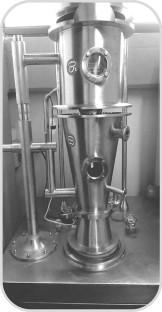Journal of Pharmaceutical Innovation ( IF 2.6 ) Pub Date : 2023-08-15 , DOI: 10.1007/s12247-023-09765-y Federico A. Fookes , Natalia S. Velázquez , Alfredo Rigalli , Julio A. Luna

|
Purpose
The oral administration of drugs is usually the most convenient, economical, and preferred route for patients. Chitosan is a natural polymer that is biocompatible and possesses good mucoadhesion properties and has been proposed for various biomedical applications such as scaffolds in tissue engineering, wound dressing, and drug release systems. Fluoride is recognized for its ability to stimulate osteoblast differentiation and for its anticariogenic properties. When administered in low doses, it increases bone mass and reduces the risk of vertebral fractures in patients with osteoporosis. However, there is a debate about the potential negative effects of fluoride when applied in high doses or chronically. The objective of this study was to investigate the release of fluoride from chitosan microparticles loaded with fluoride and coated with two polymers, aimed at controlling its delivery.
Methods
Fluoride-loaded chitosan microparticles were developed using fluidized bed technology. Additionally, polyvinylpyrrolidone (PVP) and Eudragit® RS were applied to the particles using fluidized bed and dip-coating techniques. The obtained particles were then studied to obtain their release profiles. Infrared spectroscopy studies were conducted to analyze the chemical composition of the particles.
Results
The results showed that the coatings had a slight effect on the release of fluoride from the particles when applied using fluidized bed technology. Eudragit RS® 30D coatings by immersion were found to be more effective in sustaining release of fluoride.
Conclusion
The study provides useful insights into the use of polymeric coatings in the development of chitosan-based oral delivery systems for the controlled release of a highly soluble API.
中文翻译:

用于控制药物递送的载氟壳聚糖微粒的开发:PVP K17 和 Eudragit® RS 30D 作为包衣聚合物的比较研究
目的
口服药物通常是最方便、最经济、也是患者首选的途径。壳聚糖是一种天然聚合物,具有生物相容性并具有良好的粘膜粘附特性,已被提议用于各种生物医学应用,例如组织工程中的支架、伤口敷料和药物释放系统。氟化物因其刺激成骨细胞分化的能力和防龋齿特性而受到认可。当低剂量服用时,它会增加骨质疏松症患者的骨量并降低椎骨骨折的风险。然而,关于高剂量或长期使用氟化物的潜在负面影响存在争议。
方法
使用流化床技术开发了负载氟化物的壳聚糖微粒。此外,使用流化床和浸涂技术将聚乙烯吡咯烷酮 (PVP) 和 Eudragit ® RS 涂覆到颗粒上。然后研究获得的颗粒以获得它们的释放曲线。进行红外光谱研究以分析颗粒的化学成分。
结果
结果表明,当使用流化床技术涂覆时,涂层对颗粒中氟化物的释放有轻微影响。研究发现,采用浸泡法的Eudragit RS ® 30D 涂层在持续释放氟化物方面更有效。
结论
该研究为如何使用聚合物包衣开发基于壳聚糖的口服给药系统来控制释放高度可溶的 API 提供了有用的见解。



























 京公网安备 11010802027423号
京公网安备 11010802027423号